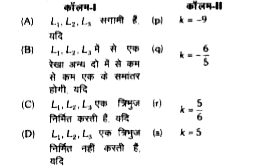यदि n∈N, तब (1+i√3)n+(1−i√3)n=
2n+1cos(nπ3)
2ncosnπ/3
2n+1cosnπ/6
cosnπ/6
The correct Answer is:A
Step by step video, text & image solution for यदि n in N, तब (1+isqrt3)^n+(1-isqrt3)^n= by Maths experts to help you in doubts & scoring excellent marks in Class 12 exams.
Updated on:21/07/2023Topper's Solved these Questions
- सम्मिश्र संख्यायेंBook:ERRORLESS HINDIChapter:सम्मिश्र संख्यायेंExercise:Exercise
Explore 117 Videos
- सम्मिश्र संख्यायेंBook:ERRORLESS HINDIChapter:सम्मिश्र संख्यायेंExercise:Jee Advanced (More than one correct Answers)
Explore 23 Videos
- सम्मिश्र संख्यायेंBook:ERRORLESS HINDIChapter:सम्मिश्र संख्यायेंExercise:Solved Multiple Choice Questions (सम्मिश्र संख्याओं की ज्यामिति)
Explore 42 Videos
- समुच्चय सिद्धान्त तथा सम्बन्ध Book:ERRORLESS HINDIChapter:समुच्चय सिद्धान्त तथा सम्बन्ध Exercise:JEE Advanced (Reasoning type questions)
Explore 3 Videos
- सरल रेखा Book:ERRORLESS HINDIChapter:सरल रेखा Exercise:JEE ADVANCE (Matrix Match type questions)
Explore 4 Videos
Similar Questions
यदि z≠0 एक सम्मिश्र संख्या हो, तो
View Solutionमाना z1 तथा z2 दो सम्मिश्र संख्याएँ इस प्रकार है कि z1≠z2 तथा |z1|=|z2| . यदि z1 धनात्मक वास्तविक भाग तथा z2 ऋणात्मक काल्पनिक भाग है, तब z1+z2z1−z2 होगा
View Solutionसमीकरण z¯z+a¯z+¯az+b=0,b∈R एक वृत्त निरूपित करेगा यदि
View Solutionमाना R वास्तविक संख्याओं का समुच्चय है
कथन-1 : A={(x,y)∈R×R:y−x एक पूर्णांक है} R पर एक तुल्यता संबंध है |
कथन-2 : B={(x,y)∈R×R:x=αy किसी परिमेय संख्या α के लिए} R पर एक तुल्यता संबंध है |
View Solution
View Solutionयदि n∈N तब 11n+2+122n+1 द्वारा विभाजित है :
View SolutionIf n is a positive integer and (1+i√3)n+(1−i√3)n=2n+1cosθ, then the value of θ is
View SolutionIf n is a multiple of 3, then (−1+i√32)n+(−1−i√32)n
View SolutionIf n is an integer and z=−1+i√3, then z2n+2n.zn+22n
View Solution⎡⎣(−1+i√32)3n+(−1−i√32)3n⎤⎦ -এর মান (n= যে-কোনো অখণ্ড সংখ্যা) নির্ণয় করো
View Solutionωn+ω2n –এর মান (যেখানে ω=−1+i√32 এবং n=3k+1)
View SolutionThe least positive integer n for which (1+i√31−i√3)n=1, is
View SolutionIf ((1+isqrt3)/(1-isqrt3))^n Is an integer, then the value of n will be
View SolutionIf n(≠3) is an integer and z=−1+i√3 , then z2n+2n,zn+22n =
View Solution(1+i√31−i√3)6+(1−i√31+i√3)6=
View Solution